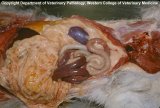| Parvovirus |
 |
 |
|
| |
| Causative Agent |
-
Parvovirus is an infectious
viral disease that affects some
wild and domestic carnivores.
-
Worldwide, several variants
of the
virus have been identified, each
associated with a single wild animal host species that acts as a
reservoir of infection for a particular geographic area.
|
| Images |
|
Click on
image to
enlarge. |
 |
|
Inflammation of the inner
walls of the intestine are commonplace in parvovirus infections
as observed in this coyote. |
|
| Distribution |
|
Geographic: |
|
|
|
Seasonality: |
-
Throughout the year; but most often in late spring and early summer when
there is an abundance of susceptible animals (i.e., young of the year).
|
|
| Hosts, Transmission and Life
Cycle |
| Hosts: |
-
In BC, the potential hosts of parvovirus include susceptible wild and
domestic animals: dogs, cats, coyotes (Canis latrans),
wolves (Canis lupus), raccoons (Procyon
lotor),
mustelids, foxes (Canidae), and bears
(Ursidae).
|
|
Transmission and Life Cycle: |
-
Transmission generally occurs through ingestion of
viral particles passed in the
feces of an infected animal rather than through direct
contact with another animal.
-
Parvovirus is hardy, stable
when frozen, and capable of surviving for at least several
months under dark, cool, and moist conditions.
-
Birds, rats, flies and
inanimate objects (fomites)
have been implicated in
mechanical transmission of parvovirus.
-
Life cycle in animals greater than 4 weeks in
age:
-
upon
entering the body, the
virus begins replication in
lymphoid tissue;
-
virus
spreads throughout the body
via blood vessels and infected
lymph cells;
-
in particular, parvovirus
targets rapidly dividing cells in the body, such as
those in the intestinal walls;
-
damage occurs through the
killing of cells of the intestinal wall, which do not
immediately
regenerate. As a result, tissue fluids and blood are
lost into the intestine. Diarrhea follows, often
containing blood and mucous;
-
with the loss of fluids,
dehydration occurs and the potential uptake of toxins
normally voided in the feces increases;
-
provided
animals survive this initial phase of the disease,
complete recovery is possible as cell populations
regenerate.
-
Life cycle in animals less than 4 weeks in
age:
-
infection of the gut is not
observed in young animals;
-
infection of the developing
brain or heart has been observed in kittens and puppies,
respectively.
-
Immunity
may be passed from mother to
offspring in dogs.
-
If an infected animal recovers after
exposure to the
virus, natural immunity usually
persists.
-
Parvovirus is not thought to have any
population level effects in wildlife, except in small
populations that are isolated from sources of
immigration, such as on islands.
|
|
| Signs and Symptoms |
-
Four to five days after exposure, infected animals may
be anemic from loss of blood,
dehydrated, depressed, tired and lacking an appetite. This is
followed by fever, vomiting and diarrhea.
-
Parvoviral diarrhea is
watery, pasty or porridge-like, foul-smelling, and often contains
blood and mucous.
-
Animals that resume eating
within 3-4 days after infection usually survive. Most animals that
die from the infection do so within 4-5 days. Infected animals can
shed the
virus for up to 2 weeks.
|
| Meat Edible? |
-
Carnivore meat is usually not consumed; however, if an animal is
suspected of being infected with parvovirus, care should be taken in
removing the intestines, as infectious particles may still be
present and may contaminate the local environment.
-
Areas contaminated with feces containing parvovirus should be cleaned
with bleach.
|
| Human Health Concerns and
Risk Reduction |
-
There is no evidence to suggest that humans are vulnerable to parvovirus
infection.
|
| Samples for Diagnosis |
-
Parvovirus is usually detected in the feces.
-
Diagnosis of parvovirus infection can be made during post-mortem
examination of the
gastrointestinal tract.
|
| Further Reading |
|
|
|
|


